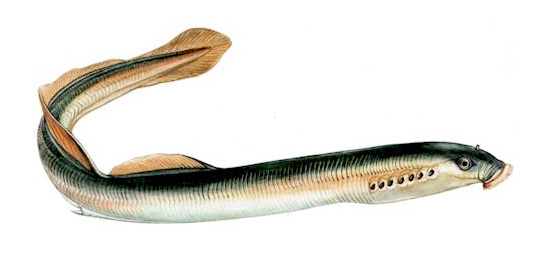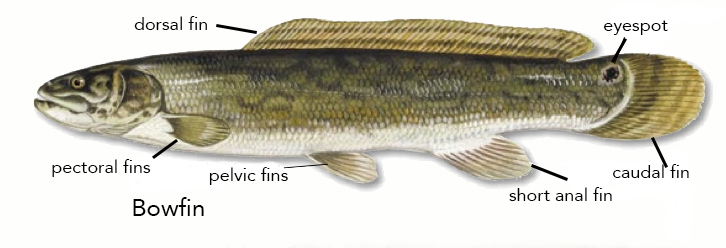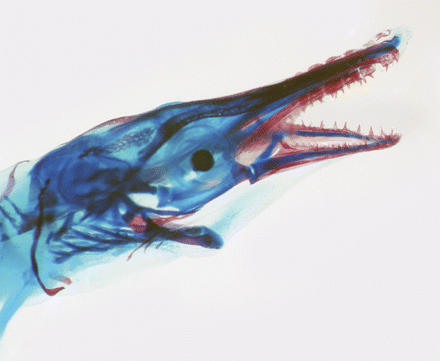|
Holosteans
Holostei is a group of ray-finned bony fish. It is divided into two major clades, the Halecomorphi, represented by a single living species, the bowfin (''Amia calva''), as well as the Ginglymodi, the sole living representatives being the gars (Lepisosteidae), represented by seven living species in two genera (''Atractosteus'', ''Lepisosteus''). The earliest members of the clade appeared during the Early Triassic, over 250 million years ago. Holostei was thought to be regarded as paraphyletic. However, a recent study provided evidence that the Holostei are the closest living relates of the Teleostei, both within the Neopterygii. This was found from the morphology of the Holostei, for example presence of a paired vomer. Holosteans are closer to teleosts than are the chondrosteans, the other group intermediate between teleosts and cartilaginous fish, which are regarded as (at the nearest) a sister group to the Neopterigii. The spiracles of holosteans are reduced to vestigial remnan ... [...More Info...] [...Related Items...] OR: [Wikipedia] [Google] [Baidu] |
Neopterygii
Neopterygii (from Greek νέος ''neos'' 'new' and πτέρυξ ''pteryx'' 'fin') is a subclass of ray-finned fish (Actinopterygii). Neopterygii includes the Holostei and the Teleostei, of which the latter comprise the vast majority of extant fishes, and over half of all living vertebrate species. While living holosteans include only freshwater taxa, teleosts are diverse in both freshwater and marine environments. Many new species of teleosts are scientifically described each year. Fossil evidence for crown group neopterygians goes back at least 251 million years to the Induan stage of the Early Triassic epoch, however, one study incorporating morphological data from fossils and molecular data from nuclear and mitochondrial DNA, places this divergence date at least 284 mya (million years ago), during the Artinskian stage of the Early Permian. Another study suggests an even earlier split (360 myr ago, near the Devonian-Carboniferous boundary). Evolution and diversity Liv ... [...More Info...] [...Related Items...] OR: [Wikipedia] [Google] [Baidu] |
Bowfin
The bowfin (''Amia calva'') is a bony fish, native to North America. Common names include mudfish, mud pike, dogfish, grindle, grinnel, swamp trout, and choupique. It is regarded as a relict, being the sole surviving species of the Halecomorphi, a group of fish that first appeared during the Early Triassic, around 250 million years ago. The bowfin is often considered a "primitive fish" because they have retained some morphological characteristics of their early ancestors. The closest living relatives of bowfins are gars, with the two groups being united in the clade Holostei. Bowfins are demersal freshwater piscivores, commonly found throughout much of the eastern United States, and in southern Ontario and Quebec. Fossil deposits indicate Amiiformes were once widespread in both freshwater and marine environments across North and South America, Europe, Asia, and Africa. Now, their range is limited to much of the eastern United States and adjacent southern Canada, including th ... [...More Info...] [...Related Items...] OR: [Wikipedia] [Google] [Baidu] |
Halecomorphi
Halecomorphi is a taxon of ray-finned bony fish in the clade Neopterygii. The sole living Halecomorph is the bowfin (''Amia calva''), but the group contains many extinct species in several families (including Amiidae, Caturidae, Liodesmidae, Sinamiidae) in the order Amiiformes, as well as the extinct orders Ionoscopiformes, Panxianichthyiformes, and Parasemionotiformes. The fossil record of halecomorphs goes back at least to the Early Triassic epoch. The Halecomorphi exhibit a combination of ancestral features, such as most heavily mineralized scales, but also by more derived or "modern" features, particularly in the structure of the skull (e.g. position and shape of preopercles). Unique derived traits (synapomorphies) of the Halecomorphi include: *Unique jaw articulation in which the quadrate and symplectic participate in the joint. *Lengthened dorsal fins (in some species) *Two biconcave vertebrae per segment in the posterior body region (a condition known as dip ... [...More Info...] [...Related Items...] OR: [Wikipedia] [Google] [Baidu] |
Amia Calva
The bowfin (''Amia calva'') is a bony fish, native to North America. Common names include mudfish, mud pike, dogfish, grindle, grinnel, swamp trout, and choupique. It is regarded as a relict, being the sole surviving species of the Halecomorphi, a group of fish that first appeared during the Early Triassic, around 250 million years ago. The bowfin is often considered a "primitive fish" because they have retained some morphological characteristics of their early ancestors. The closest living relatives of bowfins are gars, with the two groups being united in the clade Holostei. Bowfins are demersal freshwater piscivores, commonly found throughout much of the eastern United States, and in southern Ontario and Quebec. Fossil deposits indicate Amiiformes were once widespread in both freshwater and marine environments across North and South America, Europe, Asia, and Africa. Now, their range is limited to much of the eastern United States and adjacent southern Canada, including th ... [...More Info...] [...Related Items...] OR: [Wikipedia] [Google] [Baidu] |
Spiracle (vertebrates)
Spiracles () are openings on the surface of some animals, which usually lead to respiratory systems. The spiracle is a small hole behind each eye that opens to the mouth in some fish. In the jawless fish, the first gill opening immediately behind the mouth is essentially similar to the other gill opening. With the evolution of the jaw in the early jawed vertebrates, this gill slit was caught between the forward gill-rod (now functioning as the jaw) and the next rod, the hyomandibular bone, supporting the jaw hinge and anchoring the jaw to the skull proper. The gill opening was closed off from below, the remaining opening was small and hole-like, and is termed a spiracle. In many species of sharks and all rays the spiracle is responsible for the intake of water into the buccal space before being expelled from the gills. The spiracle is often located towards the top of the animal allowing breathing even while the animal is mostly buried under sediments. As sharks adapted a faster ... [...More Info...] [...Related Items...] OR: [Wikipedia] [Google] [Baidu] |
Teleostei
Teleostei (; Ancient Greek, Greek ''teleios'' "complete" + ''osteon'' "bone"), members of which are known as teleosts ), is, by far, the largest class (biology), infraclass in the class Actinopterygii, the ray-finned fishes, containing 96% of all neontology, extant species of fish. Teleosts are arranged into about 40 order (biology), orders and 448 family (biology), families. Over 26,000 species have been described. Teleosts range from giant oarfish measuring or more, and ocean sunfish weighing over , to the minute male anglerfish ''Photocorynus spiniceps'', just long. Including not only torpedo-shaped fish built for speed, teleosts can be flattened vertically or horizontally, be elongated cylinders or take specialised shapes as in anglerfish and seahorses. The difference between teleosts and other bony fish lies mainly in their jaw bones; teleosts have a movable premaxilla and corresponding modifications in the jaw musculature which make it possible for them to cranial kinesi ... [...More Info...] [...Related Items...] OR: [Wikipedia] [Google] [Baidu] |
Vomer
The vomer (; lat, vomer, lit=ploughshare) is one of the unpaired facial bones of the skull. It is located in the midsagittal line, and articulates with the sphenoid, the ethmoid, the left and right palatine bones, and the left and right maxillary bones. The vomer forms the inferior part of the nasal septum in humans, with the superior part formed by the perpendicular plate of the ethmoid bone. The name is derived from the Latin word for a ploughshare and the shape of the bone. In humans The vomer is situated in the median plane, but its anterior portion is frequently bent to one side. It is thin, somewhat quadrilateral in shape, and forms the hinder and lower part of the nasal septum; it has two surfaces and four borders. The surfaces are marked by small furrows for blood vessels, and on each is the nasopalatine groove, which runs obliquely downward and forward, and lodges the nasopalatine nerve and vessels. Borders The ''superior border'', the thickest, presents a dee ... [...More Info...] [...Related Items...] OR: [Wikipedia] [Google] [Baidu] |
Chondrostei
Chondrostei is a group of non-neopterygian ray-finned fish, while the term originally referred to a paraphyletic group of all non-neopterygian ray-finned fish, it was redefined by Patterson in 1982 to be a clade comprising the Acipenseriformes (which includes sturgeon and paddlefish) and their extinct relatives. Taxa commonly suggested to represent relatives of the Acipenseriformes include the Triassic marine fish ''Birgeria'' and the Saurichthyiformes, but their the relationship with the Acipenseriformes has been strongly challenged on cladistical grounds. Coccolepididae, a group of small weakly ossified Jurassic and Cretaceous fish found in both marine and freshwater environments, have been suggested to be close relatives of the Acipenseriformes, however, this has never been subject to cladistical analysis. Classification *Acipenseriformes ** Acipenseridae — sturgeons **Polyodontidae — paddlefishes **Chondrosteidae(†) ** Errolichthyidae(†) *Cheirolepidiformes(†) * Coc ... [...More Info...] [...Related Items...] OR: [Wikipedia] [Google] [Baidu] |
Spotted Gar
The spotted gar (''Lepisosteus oculatus'') is a freshwater fish native to North America that has an abundance of dark spots on its head, fins, and dart-like body. Spotted gar have an elongated mouth with many needle-like teeth to catch other fish and crustaceans. It is one of the smallest of the seven species of gar found in North America, growing 2–3 ft (0.61–0.91 m) in length and weighing 4-6 lb (1.8–2.7 kg) typically. Gars have diamond-shaped, thick, enamel (ganoid) scales. The name ''Lepisosteus'' is Greek for "bony scale". Gars are almost never eaten in the central and northern United States. They have high levels of mercury and are considered a cancer risk. Distribution and habitat The spotted gar is native to North America and its current range is from southern Ontario to the west from the Devils River in Texas east to the northern coast of the Gulf of Mexico and southeast to the lower Apalachicola River in Florida. The gar population is small in th ... [...More Info...] [...Related Items...] OR: [Wikipedia] [Google] [Baidu] |
Ganoid
A fish scale is a small rigid plate that grows out of the skin of a fish. The skin of most jawed fishes is covered with these protective scales, which can also provide effective camouflage through the use of reflection and colouration, as well as possible hydrodynamic advantages. The term ''scale'' derives from the Old French , meaning a shell pod or husk. Scales vary enormously in size, shape, structure, and extent, ranging from strong and rigid armour plates in fishes such as shrimpfishes and boxfishes, to microscopic or absent in fishes such as eels and anglerfishes. The morphology of a scale can be used to identify the species of fish it came from. Scales originated within the jawless ostracoderms, ancestors to all jawed fishes today. Most bony fishes are covered with the cycloid scales of salmon and carp, or the ctenoid scales of perch, or the ganoid scales of sturgeons and gars. Cartilaginous fishes (sharks and rays) are covered with placoid scales. Some species ar ... [...More Info...] [...Related Items...] OR: [Wikipedia] [Google] [Baidu] |
Paraphyly
In taxonomy, a group is paraphyletic if it consists of the group's last common ancestor and most of its descendants, excluding a few monophyletic subgroups. The group is said to be paraphyletic ''with respect to'' the excluded subgroups. In contrast, a monophyletic group (a clade) includes a common ancestor and ''all'' of its descendants. The terms are commonly used in phylogenetics (a subfield of biology) and in the tree model of historical linguistics. Paraphyletic groups are identified by a combination of synapomorphies and symplesiomorphies. If many subgroups are missing from the named group, it is said to be polyparaphyletic. The term was coined by Willi Hennig to apply to well-known taxa like Reptilia ( reptiles) which, as commonly named and traditionally defined, is paraphyletic with respect to mammals and birds. Reptilia contains the last common ancestor of reptiles and all descendants of that ancestor, including all extant reptiles as well as the extinct synapsids, ... [...More Info...] [...Related Items...] OR: [Wikipedia] [Google] [Baidu] |
Shark
Sharks are a group of elasmobranch fish characterized by a cartilaginous skeleton, five to seven gill slits on the sides of the head, and pectoral fins that are not fused to the head. Modern sharks are classified within the clade Selachimorpha (or Selachii) and are the sister group to the rays. However, the term "shark" has also been used to refer to all extinct members of Chondrichthyes with a shark-like morphology, such as hybodonts and xenacanths. The oldest modern sharks are known from the Early Jurassic. They range in size from the small dwarf lanternshark (''Etmopterus perryi''), a deep sea species that is only in length, to the whale shark (''Rhincodon typus''), the largest fish in the world, which reaches approximately in length. Sharks are found in all seas and are common to depths up to . They generally do not live in freshwater, although there are a few known exceptions, such as the bull shark and the river shark, which can be found in both seawater and fresh ... [...More Info...] [...Related Items...] OR: [Wikipedia] [Google] [Baidu] |
.jpg)






